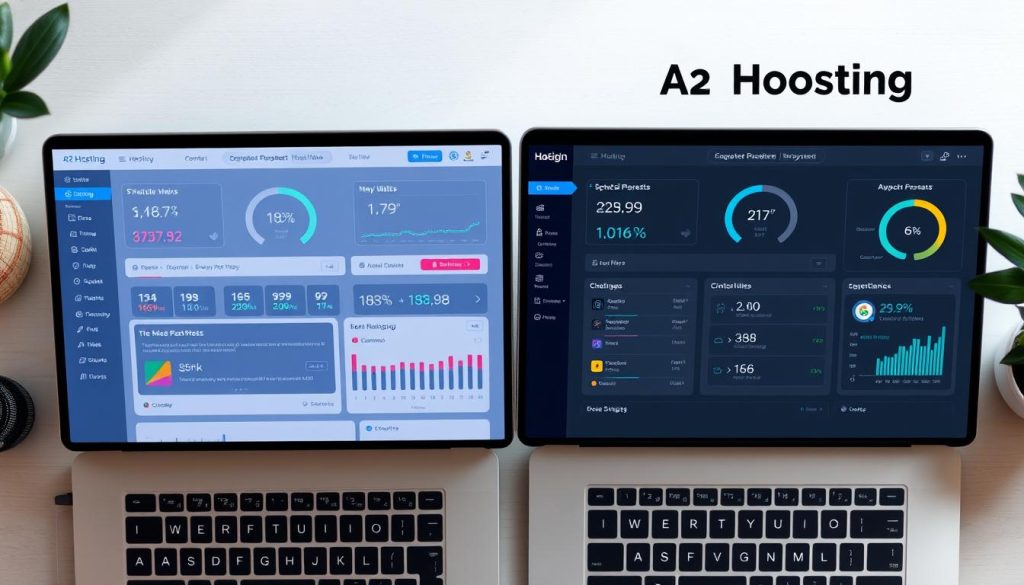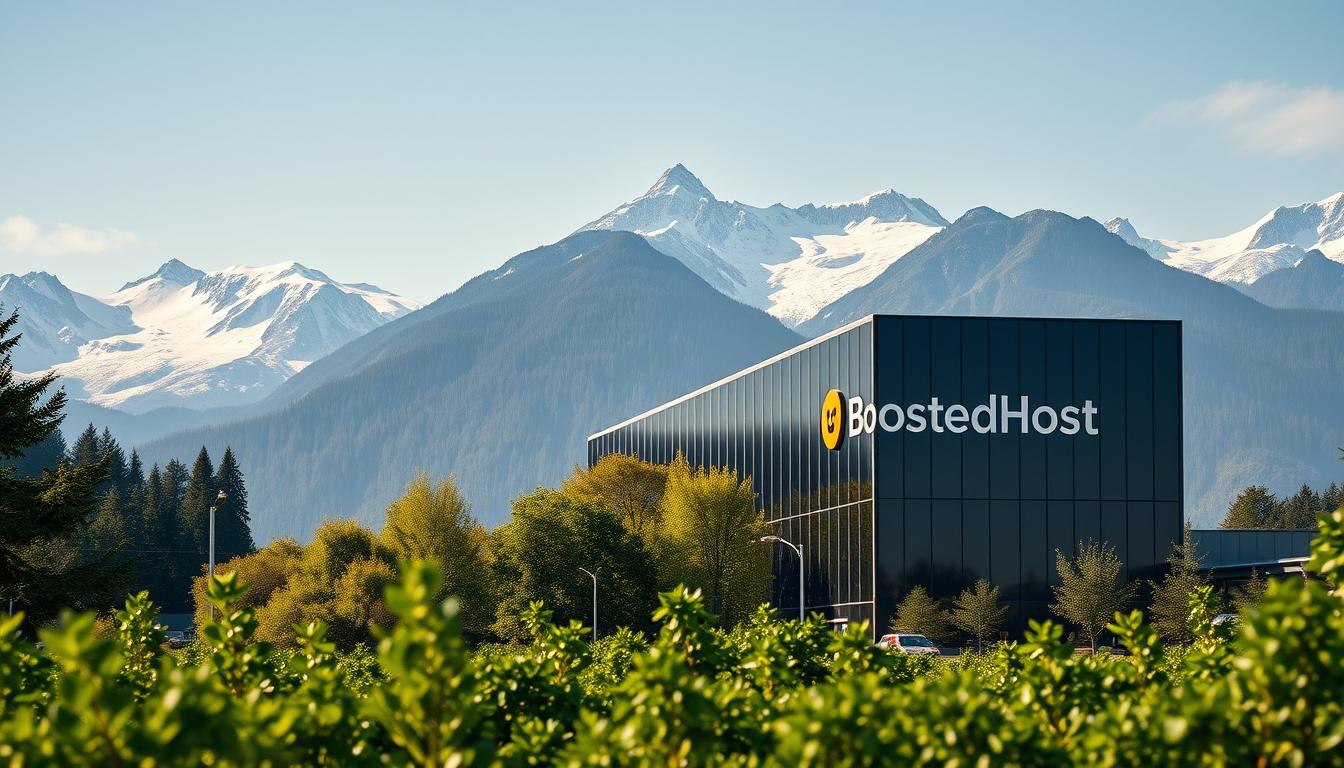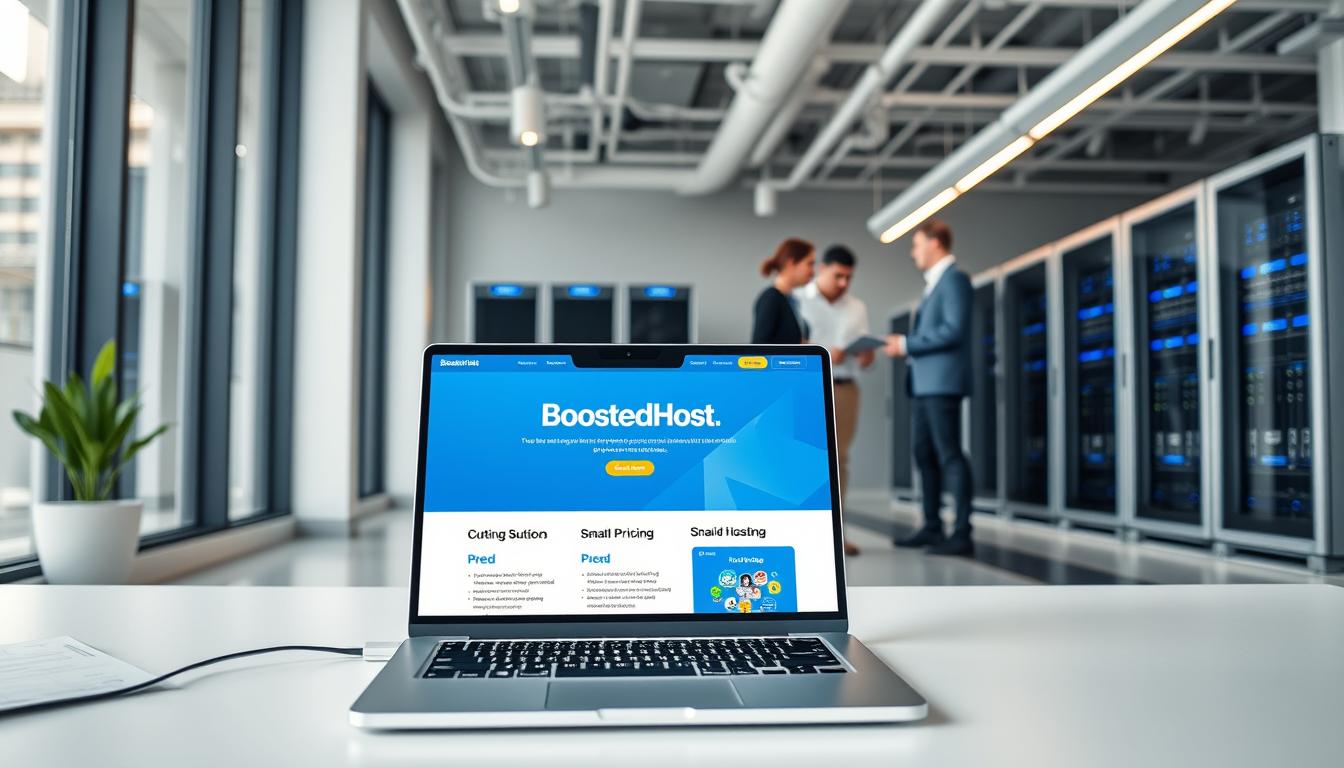We know how it feels to watch a site slow during launch week. It eats into momentum and stress rises fast.
So we built this piece as a clear, data-backed guide. Our aim is to help you pick the right web hosting partner for real results in 2025.
We’ll test speed, uptime, support, and value. We focus on how a Swiss-engineered LiteSpeed stack, global CDN, and sub-200ms TTFB translate into measurable performance for U.S. audiences.
We also examine an established Turbo stack with SSD/NVMe and caching layers that showed 1.58x gains under plugin load in independent tests. We note average load times near 391ms and stability at 99.99% uptime.
Expect clear takeaways on plans, features, pricing transparency, and support response times. We keep jargon low and recommendations practical—so your website earns speed and reliability, not hidden fees.
Key Takeaways
- We compare real metrics—TTFB, load tests, and uptime—to judge true performance.
- Swiss-engineered LiteSpeed + CDN targets sub-200ms TTFB for global speed gains.
- Turbo stacks with SSD/NVMe can beat lighter tiers under heavy plugin load.
- Transparent pricing and included features cut long-term costs.
- 24/7 expert support and fast resolution reduce downtime risk.
What this comparison covers and how we evaluated both hosts
We tested both providers across real-world scenarios to give you clear, action-ready results.
Our focus: speed, uptime, pricing clarity, included features, AI tooling, and support responsiveness. We centered tests on U.S. audiences and common CMS stacks like WordPress and WooCommerce.
Testing used long-run signals — 4,176 page loads over 29 days, continuous uptime checks, and multi-month averages. We measured page load, TTFB, regional consistency, and failure rates to reflect day-to-day use.

Key areas and decision criteria
- Real-world speed: sustained page loads and TTFB from U.S. nodes.
- Reliability: uptime monitored every minute to catch real outages.
- Cost clarity: intro vs renewal, add-ons, and total cost of plans.
- Support & tooling: response time, resolution depth, and AI launch tools.
- Platform fit: PHP versions, Node.js, Python, and WooCommerce compatibility.
| Signal | Method | Why it matters | Sample data |
|---|---|---|---|
| Page load time | 4,176 tests / 29 days | Shows user-perceived speed | Multi-month avg ~391ms |
| TTFB & regional checks | US edge nodes | Impacts first impression and SEO | Sub-200ms target vs Turbo claims |
| Uptime | 1-minute checks | Direct revenue risk metric | 99.99% observed |
| Support | Response & resolution | Shortens outages and fixes | Typical waits ~5 minutes |
BoostedHost vs A2 Hosting: quick comparison snapshot for 2025
This quick snapshot summarizes the key wins and trade-offs for 2025.
Key wins for speed, uptime, pricing, features, AI, and support
At-a-glance scorecard: we rate speed, reliability, pricing clarity, included features, AI tooling, and support responsiveness.

- Speed: sub-200ms TTFB thanks to LiteSpeed and global CDN — real world advantage for U.S. visitors.
- Uptime: consistent 99.99% averages across multi-month checks.
- Pricing: simpler, transparent billing vs attractive promos with higher renewals from the rebranded provider.
- Features: SSL, daily backups, malware protection, and CDN included — lowers total cost.
- AI & tools: Orbit launches a professional site in under five minutes.
- Support: rapid 24/7 expert help that resolves most issues fast.
Where A2 Hosting still shines and who should consider it
Independent tests show Turbo servers averaged 1.58x faster than Lite tiers over 29 days, with multi-month load times near 391ms and the same 99.99% uptime.
“Both hosts are fast; choose based on your priorities — raw server tuning or the best value density.”
Recommendation: For growth teams that want top-tier value, quick support, and fewer add-ons, lean toward the more bundled option. For users who need Turbo stack tuning or specific management features and can manage promo cycles, consider the Turbo plans.
Speed and real-world performance: LiteSpeed plus sub-200ms TTFB vs Turbo claims
Real-world speed tests reveal how architecture and CDN shape page load for U.S. visitors.
LiteSpeed stacks use an event-driven server architecture, HTTP/3, and smart caching to hit sub-200ms TTFB. Combined with a global CDN, this keeps first paint fast for American users and holds steady under burst traffic.
Turbo servers lean on NVMe, tuned caching, and server-level tweaks. Marketing says “up to 20x” faster, but measured outcomes show ~1.58x gains in 29-day tests and multi-month page averages near 391ms.
What matters most for U.S. visitors is consistency. Even pacing under load beats spiky lab peaks for ecommerce and lead-gen.
- Lower TTFB = faster first page paint and reduced bounce.
- CDN proximity improves web routing for domestic users.
- Stable performance under load improves conversions and ad quality.
| Stack | Key tech | Measured result | Best for |
|---|---|---|---|
| LiteSpeed + CDN | HTTP/3, event-driven, smart cache | Sub-200ms TTFB (US) | Consistent e‑commerce and content sites |
| Turbo NVMe | NVMe, server tuning, caching | ~1.58x faster in 29-day tests; ~391ms avg | High‑tuned apps needing raw throughput |
Pro tip: Run synthetic and RUM tests on your critical funnel pages after migration to validate real gains.
Uptime and reliability you can bank on
Every minute your site is unreachable you risk lost revenue and trust.
Consistent 99.99% averages mean near-zero downtime. That level cuts annual downtime to roughly 52 minutes. At 99.9% you lose over eight hours a year. The gap matters for paid traffic, checkout flows, and ad conversions.
We observed a steady 99.99% figure across multi-month monitoring for both major hosts in our tests. Redundancy, minute-level alerts, and automated failover keep incident windows small.
How reliability protects revenue and SEO
- Fewer crawl errors — better search indexing and steady organic traffic.
- Stable user journeys — higher conversion rates and repeat business.
- Clear maintenance windows — minimized impact on US business hours.
- Status pages and synthetic checks — monitor your most critical pages, not just the homepage.
“Near-zero downtime protects conversions and preserves brand trust.”
| Metric | 99.9% | 99.99% | Impact |
|---|---|---|---|
| Annual downtime | ~8 hours 46 minutes | ~52 minutes | Paid traffic loss, checkout failures |
| Monitoring | Hourly or daily | Minute-level with alerts | Faster incident detection |
| Business outcome | Higher risk during peaks | Stabilized funnels and retention | Better ROI on ads and SEO |
We recommend modeling lost revenue vs. premium plan cost and checking SLAs before migrating. Use continuous synthetic tests and a public status page to keep customers informed. Reliable hosting and clear incident workflows turn uptime into a competitive advantage for any business.
Pricing transparency and total cost of ownership
A clear billing model keeps growth plans predictable and painless.
Our approach maps true ongoing costs — base rates, renewal pricing, and the add-on stack many teams pay for later.
One provider favors a straightforward plan with most essentials included. SSL, daily backups, malware protection, and a global CDN come bundled. That reduces third-party bills and lowers migration overhead for agencies and small businesses.
Another provider markets attractive intro rates. Promo pricing can nearly double at renewal. Some advanced features sit behind optional add-ons like Performance Plus. That raises long-term costs and complicates budgeting.
What we recommend:
- Model total spend over 24–36 months, not just the first invoice.
- Pick a plan that includes core features to avoid extra subscriptions.
- Watch for resource overages and throttling; plan headroom into forecasts.
- Validate the money-back guarantee and trial windows before migrating.
| Item | Bundled | Often Add-on | Impact |
|---|---|---|---|
| SSL | Yes | No | Eliminates third-party cert costs |
| Daily backups | Yes | Paid add-on | Reduces recovery and migration spend |
| Global CDN | Yes | Optional | Improves US performance without extra fees |
| Performance add-on | Included on some plans | Often extra | Affects renewal bills and scaling cost |
Included features that cut extra costs
Bundled services matter more than sticker price when you model 24-month costs.
We list what comes with a plan so you avoid surprise bills later.
Core inclusions: free SSL, daily backups, malware scanning, and a global CDN. These features replace many paid third-party tools and shrink your total cost of ownership.
- Developer utilities — PHP, Node.js, and Python support for modern deployments.
- WooCommerce readiness — LiteSpeed plus CDN to speed checkout and protect conversions.
- Daily restore points — rapid recovery after plugin or theme errors without extra backups.
- WAF and malware defense — reduces cleanup costs and protects reputation.
- 24/7 expert support — most requests resolved in minutes to keep your site running.
We also note that A2/Hosting.com offers SSL, SSD/NVMe, and CDN on many plans, though some functions may be add-ons.
“Bundled features directly improve Core Web Vitals and cut emergency costs.”
| Inclusion | Value | Outcome |
|---|---|---|
| SSL | Included | SEO trust & secure site |
| Backups | Daily | Lower MTTR |
| CDN | Global | Faster US performance |
Before you buy, use a checklist of must-have features and compare long-term resource needs. For a quick vendor round-up, see our guide to the best providers for Asian businesses: best hosting providers.
Managed WordPress hosting: performance, tools, and ease of use
Performance for content and commerce matters. A tuned WordPress environment keeps editors productive and shoppers moving through checkout.
Optimized WordPress stack — LiteSpeed Cache, HTTP/3, and object caching speed dynamic pages and carts. This setup lowers TTFB and helps catalog browsing. Faster responses mean fewer abandoned carts and better Core Web Vitals.
Managed WordPress: features that matter
- WooCommerce tuning plus cache rules for fast catalog and checkout.
- Daily backups with one-click restores to de-risk plugin and theme updates.
- Staging environments and safe deploys to test changes before release.
- Clear cache do’s and don’ts to avoid double-caching with CDNs.
Real-world plugin handling and admin load
A2-Optimized WP builds managed heavy plugin sets in tests—StartUp handled 66 plugins. Turbo tiers improved WP admin responsiveness under load. That matters for complex sites and busy editors.
Practical workflow: stage updates, run vitals, test checkout, deploy.
| Feature | Benefit | Best for |
|---|---|---|
| LiteSpeed Cache + HTTP/3 | Lower TTFB, fast dynamic pages | WooCommerce catalogs |
| Daily backups & one-click restore | Faster recovery after plugin issues | Editors and small teams |
| Staging + Turbo admin | Safe testing, smoother admin UX | Complex sites with many plugins |
Choose a plan by editor count, checkout concurrency, and plugin complexity. And rely on fast 24/7 support to keep your team moving when issues appear.
AI website building: Orbit vs traditional workflows
Orbit compresses what used to take weeks into a single focused workflow.
Orbit is an AI website builder that ships a professional site in under five minutes. We answer a few prompts, pick a style, and deploy content. Then we refine branding and offers.
That saves owners and agencies valuable time. Teams can shift hours from setup to messaging and campaigns. Early prototypes validate funnels fast.
How Orbit speeds launch and keeps performance high
- Fast flow — prompt, style, deploy. Live site in minutes.
- Built-in performance — LiteSpeed stack and CDN deliver immediate web gains.
- Essentials included — SSL and daily backups out of the box.
- Extendable — developers can add PHP, Node.js, or WooCommerce later.
Compared to manual drag-and-drop, Orbit cuts plugin wrangling and theme tuning. It’s ideal for SMBs and agencies that need a reliable plan to go live fast.
Pro tip: track conversion lift after launch to measure real ROI from faster deployment.
Security hardening and daily protection
Protecting sites means layering prevention, detection, and fast recovery.
We build a hardened stack with free SSL, WAF policies, and daily malware scans. These core protections reduce the blast radius of common CMS attacks and keep user sessions safe.
Proactive monitoring flags suspicious behavior early. That lets our team triage issues before they affect conversions or data. We also enforce least-privilege access, MFA on control panels, and automated plugin and theme updates.
One competitor — A2 — offers a perpetual security posture with dual firewalls and daily virus scans. Both providers deliver solid baseline protections, QUIC/HTTP3 support, and modern TLS handshakes for faster, safer connections.
- Built-in defenses cut third-party subscriptions and simplify ops.
- Secure backups and encrypted transport keep recovery clean.
- Compliance teams should enable logging, retention, and change tracking.
- Playbook tips: isolate staging, audit admin accounts quarterly, and remove unused plugins.
“Expert support available 24/7 to triage incidents in minutes.”
| Control | What we do | Benefit |
|---|---|---|
| Access | MFA & least privilege | Lower account takeover risk |
| Detection | Daily scans & monitoring | Faster containment |
| Recovery | Encrypted backups | Safe, fast restores |
Backups done right: daily restore points and recovery speed
We treat backups as active insurance—fast, reliable, and tested so recovery is a matter of minutes, not hours.
Daily backups run automatically across the plan. Snapshots capture files and databases every 24 hours. One-click restores roll a site back quickly. That reduces downtime and limits data loss during plugin updates or failed deploys.
Pre-update snapshots are standard for WordPress and WooCommerce. That means a safe rollback if checkout breaks. Our support team stands ready to assist restores and to migrate data when needed.
- Scope & retention — full file + database snapshots with short retention and archive options for longer terms.
- Restore speed — minutes for typical restores, lowering revenue risk from outages.
- Cost and complexity — bundled features replace paid add-ons elsewhere and simplify ops.
- Offsite exports — keep orders and customer exports offsite for added resilience.
Pro tip: run periodic test restores and align backup schedules with major campaigns to ensure fast, reliable recovery and fewer 5xx errors that hurt SEO.
| Item | Included | Why it matters |
|---|---|---|
| Daily snapshots | Yes | Quick rollback after updates |
| One-click restore | Yes | Minimizes downtime and support time |
| Offsite exports | Recommended | Extra protection for customer data |
Data centers, global CDN reach, and proximity to your audience
Where your servers sit shapes real-world speed and user experience. We map physical locations and edge coverage so you can pick regions that lower latency for key users.
Switzerland, USA, Europe, and Asia footprints compared
Multiple data centers in Switzerland, the USA, Europe, and Asia shorten network hops. A broad CDN puts cached copies close to visitors. That reduces origin pulls and keeps TTFB under our sub-200ms target for many routes.
Bitcatcha-style checks show one competitor was very fast in US metros but slower on some Asia routes. That pattern proves a point: choose server locations that match your analytics.
- Pick primaries by traffic: set the primary region where most users live.
- Set failover: place a secondary region in a nearby continent for resilience.
- Pre-warm edges: prime caches before big campaigns to avoid cold-hit spikes.
Pro tip: run synthetic tests from major US metros and use real-user monitoring to verify gains after migration.
| Factor | Why it matters | Action |
|---|---|---|
| Proximity | Lower latency to users | Choose US nodes for domestic traffic |
| CDN reach | Fewer origin hits, faster pages | Validate edge coverage for target markets |
| Peering & routing | Consistent Core Web Vitals on mobile | Test from cellular and desktop across metros |
For agencies, distribute sites regionally to optimize local SEO and UX. Our support team advises the best placement based on your analytics and growth plan. That turns data into steady performance for your site.
Developer stack and future growth: PHP, Node.js, Python, and more
A modern dev stack should let teams ship features fast and scale without surprises.
We support modern PHP builds, Node.js apps, and Python services so full‑stack teams deploy without workarounds.
CLI access, Git-based deploys, and simple CI/CD hooks let developers push safe changes. Staging environments and WP‑CLI make testing and rollbacks routine.
Scale guidance: monitor CPU/RAM usage and upgrade your plan when sustained concurrency rises. For heavy APIs or high checkout loads, move to managed VPS or a higher tier for predictable resources.
WooCommerce and API-driven sites benefit from LiteSpeed dynamic caching and object cache strategies to keep carts and APIs responsive under peak usage.
Pro tip: pin PHP versions, use MultiPHP in staging, and run APM + synthetic checks before a major launch.
| Feature | What we offer | When to upgrade |
|---|---|---|
| Runtimes | PHP, Node.js, Python | Need for background workers or realtime apps |
| Access & tooling | CLI, Git deploys, staging, WP‑CLI | Team workflows and CI/CD adoption |
| Scaling | Tier upgrades, managed VPS options | Sustained CPU/RAM overages or high traffic |
We also recognize A2/Hosting.com’s mature dev tooling—managed/unmanaged VPS, cPanel/Plesk, and root access—suits custom environments. Use logging, APM, and load tests as part of your release checklist to keep web performance steady and developer experience predictable.
Support responsiveness: minutes to resolution, 24/7 expertise
Fast, practical support changes a stressful launch into a smooth sprint. We treat support as a core product—equal to speed and price. Quick, expert guidance prevents downtime and preserves conversions.
BoostedHost: expert help that resolves most requests in minutes
Our team staffs senior engineers around the clock. Most issues get resolved in minutes, not hours. That matters during launches and traffic spikes.
- Priority triage: outages get instant escalation; routine questions queue with clear ETA.
- Proactive guidance: caching, CDN, and plugin advice to prevent repeat incidents.
- Migration help: white‑glove transfers reduce risk and time-to-live.
A2 Hosting: 24/7 chat, phone, and ticket channels
They offer phone, chat, and tickets with deep technical knowledge. Response times often appear near five minutes for initial contact.
Support equals uptime: fast resolution keeps teams shipping and customers buying.
| Area | Typical SLA | Benefit |
|---|---|---|
| Outage | Immediate escalation | Minimized revenue loss |
| General questions | Minutes to hours | Clear expectations |
| Migration | White‑glove options | Smoother cutovers |
Try real scenarios during the trial or refund window. That validates support, improves your in-house runbooks, and protects your website experience.
What independent tests say about A2 Hosting performance
To separate marketing from reality, we executed a 29-day full page load study on identical heavy WordPress sites.
We ran 4,176 full page load tests comparing Turbo (with Performance Plus at $3/mo) against Lite. Turbo averaged 1.58x better real-world performance and delivered roughly a 3‑second improvement under a 66‑plugin setup.
Both plans showed excellent uptime during the window. Lite behaved a bit more consistently in those tests, while Turbo gave higher peak speed and smoother WP admin under load.
Key takeaways:
- Large sample size — 4,176 tests over 29 days for reliable data.
- Turbo: ~1.58x faster than Lite in the test matrix; notable admin responsiveness with many plugins.
- Multi-month independent numbers report ~391ms average load speed and 99.99% uptime.
Context matters: plugin mix, theme weight, and region change results. The competitor’s sub-200ms TTFB claim (LiteSpeed + CDN) remains a real advantage for US visitors. Our review: this provider is fast and reliable; the other option focuses on bundled value and ultra-low TTFB.
| Signal | Measured result | Notes |
|---|---|---|
| 29-day tests | 4,176 page loads | Turbo 1.58x vs Lite |
| Plugin-heavy load | ~3s faster (Turbo) | 66 plugins in test |
| Multi-month | ~391ms / 99.99% uptime | Stable real-world average |
Context update: A2 Hosting branding in 2025 and what stays the same
A recent acquisition and rebrand changed the name on the door, not the team inside. In January 2025 World Host Group acquired the long-standing provider and consolidated the brand under Hosting.com. The new domain reportedly cost $2 million — a sign they plan to invest for the long term.
What stays consistent
- The core platform, Turbo positioning, and support philosophy remain intact.
- Engineering teams and most tooling continue without disruption.
- An anytime money-back guarantee is preserved for existing and new customers.
If you are comparing hosting companies, focus on present-day metrics. Independent performance figures for the underlying platform still apply despite the name change.
Name and positioning shifts vs the core platform and plans
Expect updated plan names and refreshed marketing. Still, the technical stack and plans you rely on should be familiar. Check SLAs and exact plan details before you buy. Evaluate the web host on speed, uptime, support, and total cost — not just a new logo.
Bottom line: branding evolved, platform DNA is largely consistent. Compare features and SLAs, then decide.
Which plans are best for individuals, small businesses, and agencies
Plan selection is about predictable costs and the right resources for your growth stage. Start by mapping traffic and concurrent users to CPU and RAM needs. That avoids overpaying for idle capacity.
Individuals & hobby sites: pick an entry plan with bundled SSL and daily backups. It keeps costs low and offers a safe place to grow.
Small businesses & ecommerce: choose managed WordPress or an optimized shared plan that includes WooCommerce readiness, fast support, and daily restores. These features protect revenue and reduce ops work.
Agencies & multi-site managers: favor tiers that simplify multi-site control, transparent pricing, and white-glove migrations. VPS or reseller options are the right option when sustained concurrency or complex plugins appear.
| Use case | Recommended plan | Growth trigger |
|---|---|---|
| Personal blog | Entry shared plan | Traffic >5k/mo |
| Local business / store | Managed WP | Checkout spikes or Cart concurrency |
| Agency / portfolio | VPS / reseller | Multiple client sites or sustained CPU load |
Simple scoring: speed, uptime, support, inclusions, renewals — score each and choose the plan that minimizes 24–36 month costs.
Migrations, SLAs, and money-back policies
A clean migration and clear SLA turn a risky cutover into a confident move.
We run white-glove migrations that minimize downtime and keep DNS cutovers clean. Our 24/7 support team stands ready to assist during the cutover window. Fast responses shorten risk and speed validation.
Industry refund safety nets matter. One major provider offers an anytime money-back guarantee that is prorated after 30 days. Published SLAs commonly promise a 99.9% uptime target and explicit credit rules.
- Schedule migrations during low-traffic windows.
- Use staging and test critical flows before cutover.
- Keep support channels open—chat, phone, and tickets—until verification.
Pro tip: document baseline metrics (TTFB, LCP, error rates) and use the refund window to stress-test critical pages.
| Topic | What to expect | Common policy | Action for users |
|---|---|---|---|
| Migration | White-glove transfers, DNS help | Free migrations available | Schedule low-traffic cutover |
| SLA | Uptime & response times | Often 99.9% uptime guarantee | Confirm credits and thresholds |
| Refunds | Trial & prorated returns | Anytime money-back prorated after 30 days | Use window to validate performance |
| Support | 24/7 channels | Chat, phone, tickets | Keep communication tight post-cutover |
SLAs and guarantees are safety nets. Day-to-day, responsive support and clear migration playbooks are what protect your site and your customer experience over time.
Conclusion
The bottom line: pick the host that turns speed into steady revenue with the least friction. For most U.S. sites we found the leader on speed-to-value—sub-200ms TTFB, consistent 99.99% uptime, and tight performance under load. That combination wins for real users and search engines.
We recommend the provider that bundles core features and fast customer support. Included SSL, daily backups, malware defense, and Orbit’s five-minute launch cut costs and time to market. If you want to review plans directly, see our linked overview for more details: BoostedHost plans.
That said, A2/Hosting.com’s Turbo stack is a strong alternative—great raw throughput (1.58x in tests) and deep tech support. Choose by long-term cost predictability, required features, and how quickly support resolves issues. Test critical funnels during the refund window and pick the plan that scales with your goals.
FAQ
Which host delivers better real-world speed for WordPress in 2025?
We found the provider using LiteSpeed and a global CDN consistently posts lower TTFB and faster page loads in real-world WordPress tests. That said, Turbo-class servers with NVMe can still perform very well for optimized sites. Look at measured load times, CDN presence, and caching stack when choosing.
How reliable are uptime guarantees and why does 99.99% matter?
A 99.99% uptime average translates to minutes of downtime per month, not hours. For e-commerce and business sites, those minutes matter for revenue and SEO. Check historical third-party uptime reports and the provider’s SLA for credits and remediation steps.
What’s the difference between introductory pricing and total cost of ownership?
Intro rates can be attractive but renewals, add-on fees, domain transfers, and required backups raise TCO. We recommend comparing renewal prices, included features (CDN, backups, SSL), and resource limits to see actual long-term cost.
Do either provider include domain registration and email hosting?
Some plans include a free domain for the first year and basic email accounts. Others charge separately for domain renewals and premium email. Verify domain transfer fees, WHOIS privacy, and mailbox limits before committing.
How good is managed WordPress support and plugin handling?
Both providers offer managed WordPress tools—optimized stacks, staging, and automated backups. One focuses on an optimized server stack and developer tools; the other bundles staging, plugin conflict checks, and curated WP support. Check response times and restoration SLAs for peace of mind.
How fast can I migrate my site and is migration free?
Many hosts provide free or assisted migrations for standard WordPress sites. Large custom apps or databases may need manual migration support. Expect migrations to complete within hours to a couple of days depending on complexity and support queue.
What backup frequency and restore options should I expect?
Daily restore points are standard on managed plans. Look for one-click restores, on-demand backups, and retention windows. Faster recovery and point-in-time restores reduce downtime and data loss risk for high-traffic sites.
Is an AI site builder worth using versus traditional development?
AI builders can launch a professional site in minutes—great for simple business sites and rapid prototypes. For complex e-commerce, custom integrations, or advanced SEO, a developer workflow and staging remain preferable.
Which security features are included by default?
Expect firewall rules, malware scanning, DDoS mitigation, and automated patching on managed plans. Look for daily scans, WAF protections, and two-factor admin access. Security extends beyond the host—keep plugins and themes updated.
How do data center locations affect my site’s performance?
Choose a data center close to your audience to lower latency. Global CDN presence helps serve visitors worldwide and reduces load on origin servers. Providers with multiple regions—USA, Europe, Asia, Switzerland—offer better geographic reach.
What developer stacks are supported if I need PHP, Node.js, or Python?
Higher-tier and VPS plans typically support PHP versions, Node.js, and Python environments. Check SSH access, Composer/npm support, and container or staging options for scalable development and deployment workflows.
How responsive is customer support and what channels are available?
Look for 24/7 chat, phone, and ticketing. Top providers resolve common issues in minutes and escalate complex requests quickly. Review independent response-time tests and customer reviews to validate support claims.
Are there SLAs or money-back guarantees I can rely on?
Most hosts offer a stated money-back window (usually 30 days) and an uptime SLA with service credits. Read the fine print: credit calculations, exclusion clauses, and support requirements can affect eligibility.
Which plans suit freelancers, small businesses, and agencies?
Freelancers benefit from entry managed plans with backups and staging. Small businesses need scalable resources and uptime guarantees. Agencies should pick plans with multi-site management, higher RAM/CPU, and priority support to handle spikes and client sites.
How do backups, security, and performance features reduce long-term costs?
Built-in backups and security reduce the need for third-party services and emergency developer time. Performance features—CDN, server-level caching, and SSD/NVMe—cut hosting resource needs and improve conversion rates, lowering overall TCO.
What independent test signals should I check when comparing hosts?
Review 28–90 day load tests, TTFB metrics, multi-month uptime averages, and real-user monitoring. Also check synthetic tests for peak response and real-world user timing in your target region.
Can I scale from shared to VPS or cloud without downtime?
Many providers support seamless upgrades to VPS or cloud with minimal downtime. Confirm migration paths, resource provisioning times, and whether snapshots or live migration are available to avoid service interruptions.
How do renewals and add-on fees typically affect long-term pricing?
Renewal rates often rise 2–4x above intro pricing. Add-ons—managed backups, premium support, dedicated IPs—add recurring costs. Factor renewals into a three-year TCO model for accurate budgeting.




